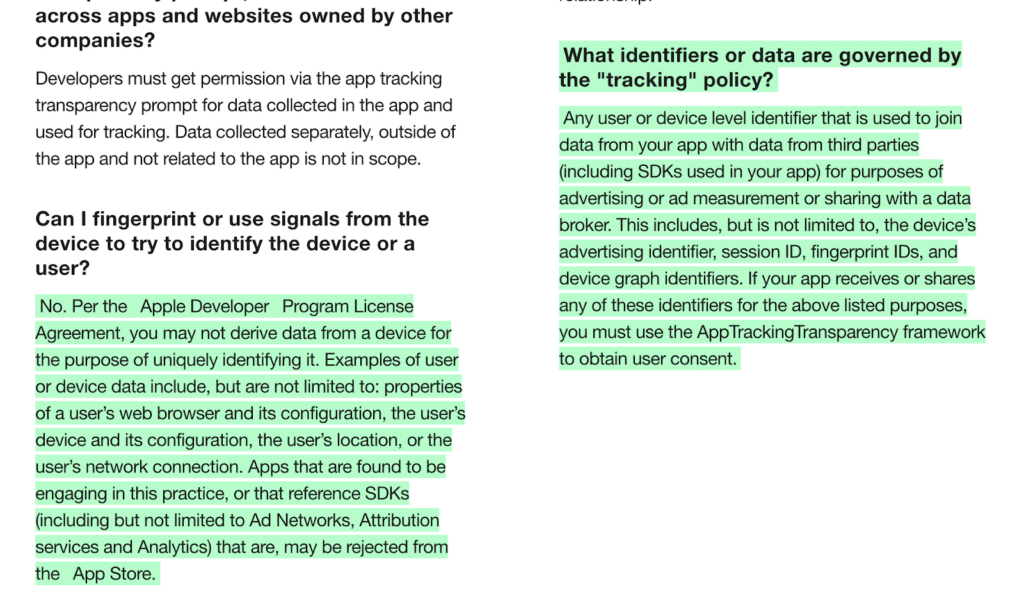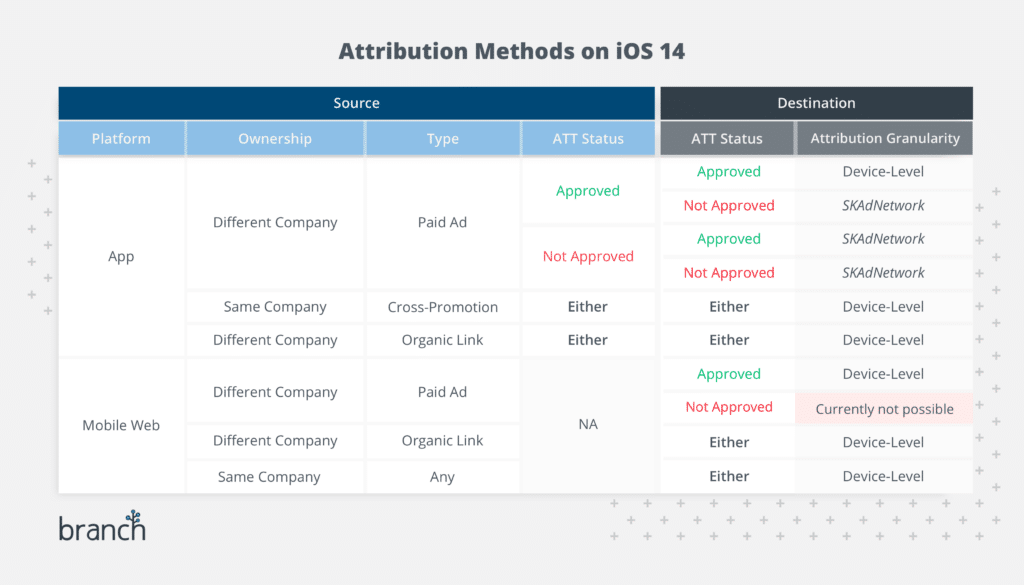
Note: iOS 14.5 is quickly approaching in the next few weeks. As of March 3rd, we recently published two new iOS 14 guides. Read this blog for necessary steps to prepare for iOS 14.5 and avoid disruption, as well as our latest ‘iOS 14 survival guide’ if you missed the boat to prepare in time.
The smoke has cleared, and it’s apparent that Apple just landed a new world order for attribution on iOS. Whether we like or not, the rules of the game are changing dramatically.
Since WWDC last summer, we have known that Apple would gate access to the IDFA (the primary device identifier used to measure mobile advertising on iOS) via their new App Tracking Transparency (ATT) framework. While this would likely lock away the IDFA for attribution purposes, Branch believed brands would still be able to continue to establish relationships with their own end users, based on user agreements and their terms of service. These relationships would legitimately grant an advertiser consent to track via methods other than the IDFA.
What’s changed?
On January 28, Apple released new guidance as part of their “Data Privacy Day.” For this discussion, the important new information is highlighted below:

This update now clarifies which user opt-in methods are acceptable for ad tracking on iOS 14. In short, Apple insists all apps gain consent for ad tracking via their new App Tracking Transparency (ATT) framework, and nothing else. If an app does not secure user opt-in via this framework, Apple has ruled that SKAdNetwork will be the only acceptable alternative. Apple has also signaled their intent to aggressively enforce these rules (at least, unless you’re one of their own apps, or using an ad network they run).
This change is coming with the next major iteration of iOS 14 — likely 14.5 in March or April — and the decision that companies must make is now simple:
- Attempt to gain user opt-in via the AppTrackingTransparency framework
This grants possible access to granular ad attribution data on iOS, and all the benefits that come with it.
OR
- Live with aggregate data only
As provided by Apple’s SKAdNetwork only.
We’ll say it up front: this is counter to our previous expectations that companies would be able to acquire consent via any legally acceptable mechanism, including, but not limited to, Apple’s ATT framework. Fortunately, we also anticipated this potential outcome and Branch has built products that fully support the new stance, but in full transparency, we share a lot of our customers’ frustrations.
Branch believes privacy is a core right. We’ve always made this incredibly clear via both our conduct and our Guiding Privacy Principles: we limit the data we collect, we will only provide you with data about actual end-user activity on your apps or websites, and we will never rent or sell personal data. In spirit, we support Apple’s drive to increase privacy protections for users.
In our view, by dictating that the ATT framework is the only allowable consent mechanism, Apple is pushing the envelope of what is acceptable for a platform owner. But, while we disagree with Apple’s approach, the reality is we have little choice but to conform. Apple has now made it explicit: apps that do not comply with the letter of their rules will be ejected from the App Store. That is a risk we are not willing to expose our customers to.
What does this mean for you and Branch?
So where does that leave us? Branch is fully equipped to support this change, and we have been building our SKAdNetwork support for the past few months to make sure we are ready.
We’ve also been hard at work, improving our probabilistic attribution methods to provide the most accurate device-level data in the industry. These improvements are real, and still available for you — the only change is that Apple has decreed that you must get user opt-in via the AppTrackingTransparency to access them for paid advertising campaigns.
For Branch customers, this is what to expect:
- No impact on Android.
- All deep link use cases, including deferred deep linking, will continue to function.
- As always, attribution will be available via probabilistic methods for owned (non-paid) channels, which are clearly exempted from Apple’s new policies.
- In cases where publishers cross-promote their apps, users will be trackable on a highly accurate, device-level basis using the identifier for vendors (IDFV).
- When users convert from a web-based ad to an app, and then grant the app the right to track via the ATT prompt, probabilistic attribution methods will be available.
- If end users opt-in to tracking via the ATT prompt on both sides of an app-to-app paid campaign, device-level ad attribution will continue to be available.
- When users do not grant permission to track via the ATT prompt on both sides of an app-to-app paid campaign, ad attribution will be possible only using Apple’s SKAdNetwork (assuming advertisers and publishers support it).
We have summarized this in the table below:

We’re aware that the ‘currently not possible’ scenario for attribution of web-to-app ads (when ATT is disapproved) is a major problem. It’s clearly prohibited by the language of Apple’s ATT policy, and unfortunately not supported by any of Apple’s new functionality. We hope Apple will clarify their intentions here.
What comes next
The past decade provided user acquisition marketers with perfect conditions to drive mobile growth. Blending precise mobile targeting and accurate audience data has been a formula for success. However we look at it, all marketers should expect major turbulence when advertising on iOS in the near future. The changes that Apple is driving will be disruptive and far-reaching. Targeting tactics, prices paid for media, and retention strategies will evolve rapidly, and the cost efficiency of stand-alone paid mobile ad campaigns will fall.
Fortunately, Apple’s new policies are very explicitly geared towards advertising measurement and advertising targeting, which means a new opportunity for owned-media and earned-media campaigns to thrive. We will see a new emphasis on organic channels, as well as a shift back to acquiring users on websites and converting them into the app later.
As Apple’s new world order takes effect, it will become increasingly critical for all parts of the mobile growth engine to work together seamlessly. More than ever, it will be vital for marketing teams to remain agile, working together as a cohesive whole to unify their efforts across all of their channels. This means maximizing the overall return on marketing spend (not just the return on advertising spend), and that has always been the true value of the Branch platform. Our mission is to help customers deliver integrated marketing experiences that boost campaign efficiency, deliver sustainable growth, and delight users.
We built the Branch platform to enable companies to deliver unified, cross-channel, cross-platform campaigns. This means that existing Branch products like deep linking and measurement for email, social, and OTT will continue to work seamlessly, providing best in class user-experiences and industry-leading attribution accuracy. Over the next few months, we will also continue to roll out new industry-leading products to support this vision, such as cross-channel multi-touch attribution to provide marketers with a deeper understanding of how their users engage with all of their brand touchpoints.
It’s a brave new world, and all of us are being pushed into it together. We’ll be following up with additional communication around what this means for customers and partners in the coming days and weeks.






















